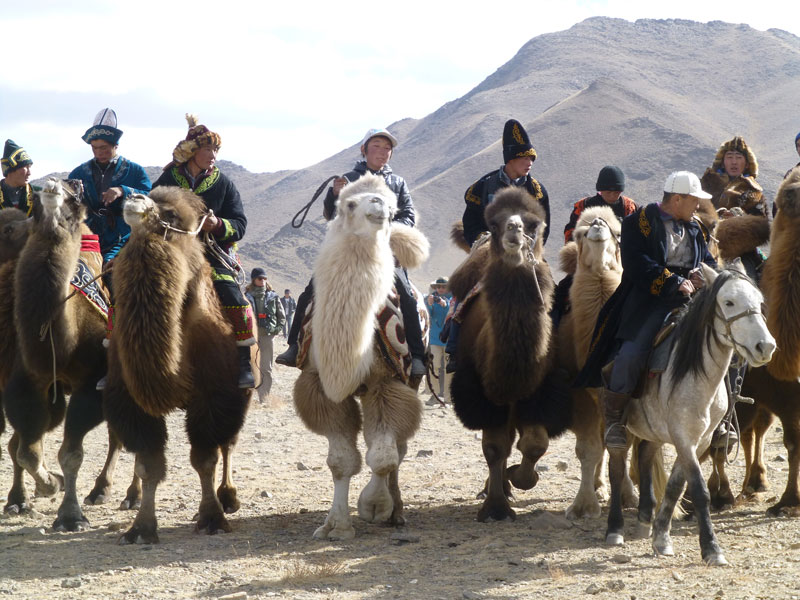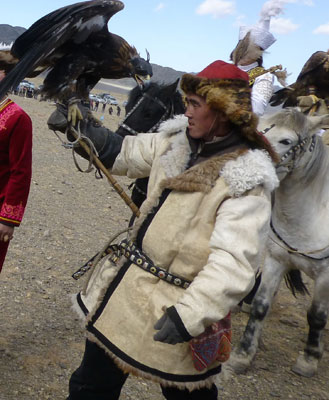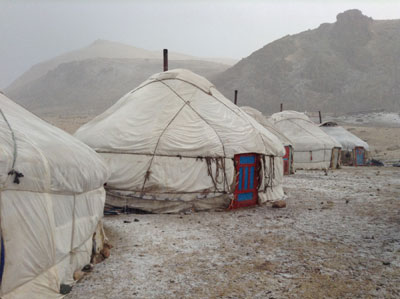Hunting with the golden eagles of Mongolia
This item appears on page 32 of the March 2015 issue.
The first time I fell in love with Mongolia was in 2008, when I hiked near Lake Khövsgöl, an immense lake close to Siberia. On a trip to Mongolia’s western mountains in 2014, I fell hard again.
The scenery made my jaw drop, the gers (yurts) were snug and exotic, and the nomadic culture was a lifestyle I had never imagined.
Getting there
From Sept. 26 to Oct. 8, I traveled to the far west of Mongolia to the Altai Mountains to see Kazakh culture and attend the Golden Eagle Festival in the town of Ulgii. My tour, run by Adventure Sherpas, consisted of 10 travelers, and our guides were company owners Kim McCluskey and Brad Ruoho.
Departing from Minneapolis, we flew into Ulaanbaatar via Seoul on Korean Air. The flights were long but comfortable. (Seoul’s airport includes a hotel inside the security section where you can get a room for a few hours to nap and shower.)
When we arrived at the airport in Ulaanbaatar, we were met by a driver who took us, in a modern bus, to the Platinum Hotel (Teeverchidiin St.). This excellent hotel had very large, new rooms, a helpful staff and a restaurant that served wonderful fried fish.
The next morning we met our Mongolian guide, Dosjan, a charming, well-educated man who spoke excellent English.
Ulaanbaatar
Ulaanbaatar is a charming city, but it has grown fast.
The traffic was oppressive — often as many as 20 drivers would run a red light — so when we needed to cross streets, we followed the Mongolian pedestrians closely.
During our stay in the city, we visited the Choijin Lama Temple Museum, Bogd Khan’s Winter Palace and the National Museum of Mongolia, whose museum shop offered fascinating books, artwork and crafts.
A real find was the Mary and Martha Mongolia shop (Chingeltei District, 1st Khoroo, Building 10, No. 18), which sells hand-spun yarn, art and handmade sweaters and shoes.
We also ate at some excellent restaurants, enjoying Indian food at Hazara (District 13), Italian food at Rosewood Coffee House (Embassy St., Midtown office) and fabulous coffee, omelets and pastries at Millie’s Espresso (Marko Polo Plaza, Jamyun Gun St.).
Into the wilderness
In an early-morning snowstorm, we flew out of Ulaanbaatar to Ulgii (Ölgii) to spend time with the people of the Altai, the Kazakhs. A minority culture in Mongolia, the Kazakhs are descended from the Turkic khans who ruled Central Asia in the 15th century.
“Remote” takes on new meaning in Mongolia. We’re not talking about having to travel a few miles on a dirt road to get from place to place. Mongolia has few roads, and most of them are merely faint tracks across rocky valleys.
We drove off-road in Land Cruisers from Ulgii, following valleys so isolated that we saw only one or two gers. (Mongolians prefer ger to the Russian word, yurt.) There were no fences, no roads, no property lines and no towns.
It was autumn, and the nomadic Kazakhs had moved their herds — thousands of yaks, cows, goats, camels and horses — from higher grazing grounds to their lower winter quarters. The vast, high valleys lay empty, waiting for wind and snow.
We saw the soft-white shapes of our gers sitting snugly under a rocky mountainside. Each structure was made from thick felt, supported by a lattice of wood. Nearby were stone enclosures for goats, to keep them safe from wolves, and behind the goats’ corral, a herd of yaks made low, comforting grunts as they settled for the night.
The nomads burned dried dung in little stoves, and the smoke had a pleasant, earthy scent.
The first valley we stayed in was near Tavan Bogd Mountain. We slept on cots, usually with two per ger, and our gers were toasty warm. (In the early mornings, while I was still warm in bed, staff would come in and build a fire.)
At each of our camps, there was a cozy ger where the staff cooked and where we ate together. There was always hot tea and a warm fire. Every morning, Kim and Brad made good, strong coffee, and many evenings we had a glass of wine before dinner.
All around the camps were easy hikes offering stunning views of the valleys and mountains. The mountains changed color, from purple to brown to blue to gray, and some were already covered with snow.
On the hunt
The Mongolians are amazing horsemen. In our second ger camp, in the Mogoit Valley, horsemen brought us gentle horses so that we could ride out to the stones that mark ancient battle sites. The riding was easy and the horsemen were good-natured.
Several group members opted out of riding and took a Land Cruiser out to join the group.
At our third camp, in the Khar Khatuu Valley, we reached the focus of our tour, staying close to the family of one of the Kazakhs’ legendary eagle hunters.
Inside of our gers it was warm and dark, with thick felt rugs on the ground. The eagle hunter’s wife had hung pelts above our beds — wolf, fox and beech marten. I woke up and fell asleep watching orange firelight dancing on the round felt ceiling.
On a chilly morning we watched the eagle hunter work with his eagle. The hunters catch young eagles and train them to hunt, releasing them back to the wild after about seven years.
The hooded eagle perched on the hunter’s arm. When he pulled off the hood, she lifted her wings and flew, looking for prey.
Later, on a brilliant blue afternoon, we went out on the mountain to hunt with the men. We were at 9,500 feet, and the wind was so cold that we pulled scarves over our faces. The hunters were on foot, though they usually hunt on horses.
Each of the two hunters carried an 18-pound eagle on his arm. Below us were “beaters” who ran along the slopes, scaring foxes out of hiding.
Soon someone spotted a fox, and, with a shout, the hunters jumped up and pulled off one eagle’s hood. She screamed as she sensed the energy of the hunt.
Normally, she would fly high and the hunters would race beneath her, but the hunter didn’t see the fox, so he put her hood back on.
Hours passed. We ran up and down the rocky slopes, tripping and stumbling, then waited, squatting in the sun and the biting wind. Some of the group members didn’t walk but sat and watched from a hillside.
Far below, a beater shouted. The fox had doubled back in the opposite direction and disappeared.
We came down the mountain to our gers and drank warm, sweet yak’s milk by the fire.
Festival time
The next day we drove to the city of Ulgii to attend the annual Golden Eagle Festival. Ulgii is a small city and has only one hotel with bathrooms en suite: the Tsambagarav Hotel (A-2, Ulgii). It’s a new hotel with good hot showers, but there’s a restaurant downstairs that hosts loud, private parties, so earplugs were needed.
A fabulous coffee shop nearby, Italian Coffee (4 r bag ih bulan num-01), served lattes, espresso and smoothies.
Hundreds of Kazakhs had come to the festival, bringing their eagles, camels and horses. Their high leather boots, fox-fur hats, long, padded tunics and fur coats made perfect sense in the harsh wind.
Our staff set up a ger just for us, with all-day hot drinks and lunches of homemade dumplings and vegetables.
Seventy men and two girls competed in skill events, such as calling their eagles from a nearby mountaintop. I especially loved the camel races, where huge Bactrian camels loped gracefully across the valley, their long fur blowing in the cold wind.
So, Mongolia stole my heart again. It’s a world apart from the centrally heated homes and busy streets of the US. The high, empty valleys, the stunning mountain vistas, the charming, cozy gers and the friendly people offered the perfect mix of comfort and adventure, and I will go back for that.



